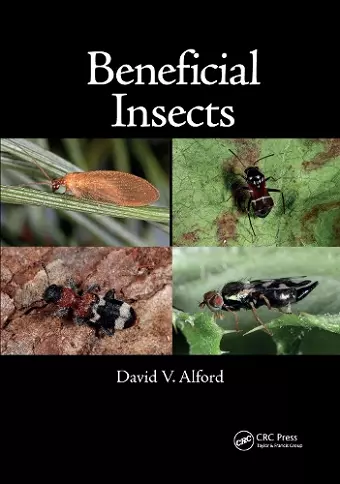Beneficial Insects
Format:Paperback
Publisher:Taylor & Francis Ltd
Published:14th Jun '22
Currently unavailable, and unfortunately no date known when it will be back
This paperback is available in another edition too:
- Hardback£175.00(9781482262605)

Highly Recommended in CHOICE, Jan 2020, Vol 57, 5
Insects are key components of life on our planet, and their presence is essential for maintaining balanced terrestrial ecosystems. Without insects humans would struggle to survive, and on a world scale food production would be severely compromised. Many plants and animals depend directly or indirectly on insects for their very survival, and this is particularly so in the case of insectivorous birds and other such creatures. The beneficial role of insects is often overlooked or misunderstood, and in farming circles their very presence on crops is often seen to be unwelcome. In reality, however, many insects are genuinely beneficial, as in the case of parasitic and predacious species. The use of chemical pesticides to control crop pests is becoming more tightly regulated and environmentally undesirable, and low-input farming, in which natural enemies of pests are encouraged to survive or increase, is becoming far more prevalent. Accordingly, Integrated Pest Management (IPM) and Integrated Crop Management (ICM) strategies are increasingly being developed, advocated and adopted.
Features:
- Highlights information on many groups of insects and mites that act as natural enemies or biological control agents of phytophagous insects and mites, including plant pests.
- Profusely illustrated with high-quality colour photographs.
- Focuses mainly on insects and mites as natural enemies of plant pests, including parasitic and predacious species that have been accidentally or deliberately introduced in classical biological control programmes.
- Reviews the role of phytophagous European insects and mites in controlling or managing European plants that have become invasive weeds in other parts of the world, notably North America, Australia and New Zealand. <
The anthropocentric perspective adopted here by renowned British entomologist Alford provides an excellent lens to reveal the complex relationships where insect life intersects positively with human valued resources. This superlative, well-illustrated overview is a valuable reference to facilitate further studies.
--M. K. Harris, emeritus, Texas A&M University, in CHOICE Jan 2020.
I liked the excellent details about what is eaten and how that is accomplished by the diverse groups of natural enemies. Some examples are well known with lots of available information while others are lesser known species for which the author has included pertinent information that I assume would be difficult to find. I also very much enjoyed the short review starting the book that frames the overall subject of beneficial insects by discussing diverse ways that insects can be useful beyond just controlling pests. The vast majority are of insects that are usually quite small, which demonstrates the author’s excellent abilities as a macrophotographer. In summary, this book provides a great compendium of the detailed biologies of the breadth of European natural enemies attacking insect plant pests and weeds.
--Ann E. Hajek, Entomology, Cornell University, Ithaca, New York, in The Quarterly Review of Biology, Volume 95, Number 1 (March 2020)
ISBN: 9781032338415
Dimensions: unknown
Weight: 980g
400 pages